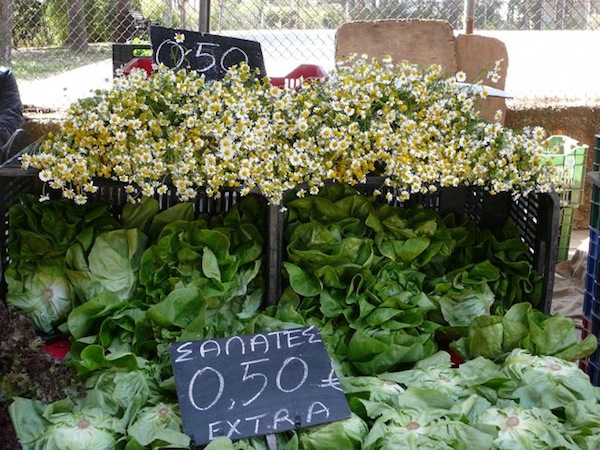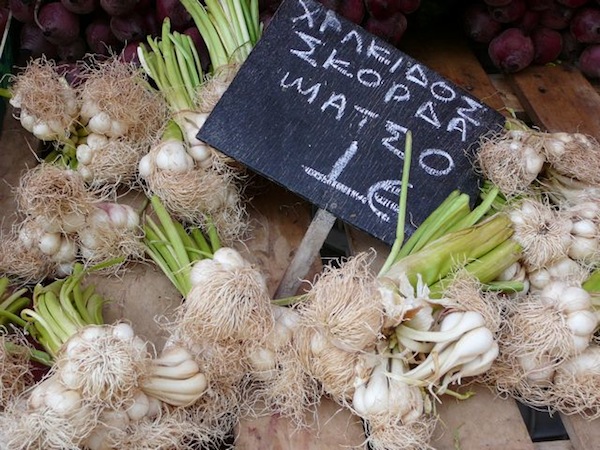The Pros & Cons Of Fasting
Eating Well Is The Best Revenge
by Diana Farr Louis
ATHENS Greece—(Weekly Hubris)—4/25/11—“What’s been the hardest thing to give up during these six weeks of Orthodox fasting?”
It’s the second question that comes up, after, “Why on earth are you doing it?”
The why is easier to answer. Like climbing a mountain because it’s there, I decided to abstain from all animal products just to see if I could. And what I might learn from the experience.
People also wonder, “Do you feel any different?” And the answer to that is NO. Nothing changed. Not weight nor sleeping patterns nor digestion nor even bathroom visits. I felt pretty good before and feel pretty good now. Perhaps I’ll notice differences when I go back to being an omnivore and eat too much roast kid on Easter Sunday.
I will let you know.
Meanwhile, fasting Greek-style has been remarkably easy. Especially at home. I’ve cooked lots of “musical fruit”—the bean, lentil, chickpea family—in soups, salads, and falafel. Lots of satisfying Greek vegetable dishes with young artichokes, peas, and broad beans with lemon and olive oil. A few risotto/pilafs with spinach, chard, cabbage, and/or leeks. Even a cauliflower au gratin with olive oil instead of butter, vegetable broth instead of milk, and piquant capers instead of cheese.
Spring onions and fresh garlic—looking like baby leeks—and incredible organic asparagus, found at the farmers’ market for a mere 3 euros a big bunch, have perked up many suppers. While I hardly need to mention how soothing tiny new potatoes can be.

Lunches tend to be salads. These days, some farmers’ stalls are a mass of gorgeous lettuces in every shade of green, brown, and red, plus bunches of sweet-smelling herbs, from mint, parsley, and coriander to wild fennel, oregano, rosemary, and kafkalithra (tordyllium), which has a kind of musky taste that adds a certain something to soups. One man in our local market specializes in shiny Cretan avocados that mix well with arugula, watercress, and stamnagathi, a sharp Cretan dandelion-lookalike in fashion now, if we don’t gobble them on their own with just a little oil and lemon.
No, the menu at home has been varied and temptation-free these past six weeks. The saucisse seche is drying out further on the breadboard, unmolested by me. My husband’s cheeses—whether blue, white, or yellow—leave me indifferent. And those country eggs he bought a month ago sit in the fridge untouched. Sadly, that is a waste. They’ll be too old to dye.
Even eating out has been fairly problem-free. Most Greek restaurants offer fasting dishes since it’s such a part of the tradition. Even the Pi Box, an upmarket but affordable all-day eatery run by one of Greece’s celebrity chefs, caters to fasters. That was not immediately obvious. The written menu devoted whole pages to charcuterie, imported cheeses, appetizers, main courses, salads, and sandwiches, but all contained some forbidden substance.
It wasn’t until I whimpered, “Nistevo” (I’m fasting) that the waiter reeled off the Lenten specialties. Each sounded delectable but I finally settled on purée of Santorini fava with octopus carpaccio drizzled with truffle oil. Explaining that fava is split yellow peas does not begin to convey how sublime this dish was. Normally, it’s just a taverna staple, good but rustic, topped with sliced onions, olive oil, and lemon juice. But this was, well, worth fasting for.
Truth be told, the only food I’ve really missed is fish. Plain old grilled fish. You’d think that a steady diet of seafood—shrimps, octopus, mussels, and kalamarakia (squid)—would be no hardship. After all, real vegans don’t do molluscs and crustaceans. Ever.
But, in practice, it has meant having to eat fried squid almost exclusively. Shrimp and mussels turn up less often.
So I was excited when March 25th came along. Not only is this Greek Independence Day, with all the expected parades and flag-waving, it also commemorates the Annunciation of The Virgin. And for some arcane reason, the Orthodox are allowed to eat fish in celebration. Not just any fish, though. Only salt cod.
Perhaps the preservation process is so far removed from the live creature with blood flowing through its veins that one can pretend it never had any. Which also raises the question of why fish eggs—caviar and taramosalata—are permissible, but not hens’ eggs? Any ideas?
We rarely eat salt cod at any other time of year, and for a couple of weeks it calmed my fish cravings. Tavernes serve it batter-coated and deep-fried with skordalia sauce (think Very garlicky, cold mashed spuds laced with olive oil; certainly not milk), a combination of hot/cold, crunchy/creamy, salty/pungent that really works. But it’s too fussy to do at home, so I made a couple of easy stews, one with leeks and spinach from Crete, the other with garlic, potatoes, and hot pepper from Corfu. Perhaps I cheated by not confining their consumption to the 25th of March.

Which brings me to confession time. Oh, Dear Reader, I hope you won’t be too critical, but I did eventually cave in to my longing for the plain white flesh of a simply grilled fish. Two Sundays before Easter. I’d been dreaming about the fish that would break the fast. Would it be a red mullet tasting of iodine, or a gray mullet butterflied as they do in Missolongi, an ordinary but tasty mackerel or even pair of humble goppes (whose Latin name, boops boops, is the most entertaining of all), flaky bream or firm monkfish? It didn’t matter. Just thinking about them conjured up the seaside and the ubiquitous tavernes that cook them to perfection over charcoal in so many parts of this country.
And so it was we combined a visit to the ancient site of Rhamnous, near Marathon, with a meal at a beach-front taverna.
There the menu was all meat and fish—glistening, fresh, finny creatures on ice, or the same old frozen squid rings? I just couldn’t face another plate of fried kalamarakia. And so I broke my vow not to eat fish until Easter. I went into the kitchen and chose a small sargos (bream) from the fridge drawer. It should have been perfect, grilled with a little oil/lemon dressing on the side.
But I was punished for my sin. The fish arrived floating in a sauce of oil, lemon, and mustard! The addition almost wrecked its natural taste and left me chastened. Served me right.
By the time you read this, we will have celebrated Easter. Almost everyone I know fasts during Holy Week, so no more temptations will come my way.
What have I learned? That I’m reasonably disciplined but not rigidly so. That fasting is economical, lighter on the tummy, and makes shopping easier, with whole sectors of supermarkets out of bounds. But also that while fasting is fine, I’d rather be an omnivore—obedient to the Ancient Greek golden rule: Nothing in Excess.
Now there’s a real challenge.

Two More Fasting Recipes
Artichokes, Peas & Broad Beans
You don’t really need a recipe for this. It’s just to give you ideas. You can expand it as needed.
4 young artichokes, trimmed, tough leaves discarded, and quartered, chokes removed
1 cup fresh peas (about 1 lb/1/2 kg in the pod)
1 cup broad or fava beans (about 1 lb/1/2 kg in the pod)
4-5 spring onions, chopped
chopped mint, parsley, dill, and/or fennel tips, a handful each
2-3 tablespoons olive oil (or more)
grated lemon peel and 2 tablespoons lemon juice, or more
1 tablespoon cornstarch
Sauté the onions in the oil for 3-4 minutes over medium heat. Add the vegetables and herbs, saving a little of each to sprinkle over the finished dish. Coat them in the oil, stirring lightly, and cook another 2 minutes or so. Then add the grated peel and water to barely cover the vegetables, and simmer, covered, for about 15 minutes. Check the water level; don’t let them stick. The timing depends on the tenderness of the artichokes.
When the veggies are to your liking, mix a couple of tablespoons of their cooking liquid with the cornstarch and lemon juice in a small bowl and pour back into the pan. Shake to mix or stir very gently. This will thicken the sauce a little. Sprinkle with the extra chopped herbs and serve.
This will feed about three people. Any leftovers are delicious at room temperature.

Salt Cod Bourdetto from Corfu
This is a lovely light dish from Prospero’s Kitchen. The word bourdetto is a corruption of the Italian brodetto and reflects the Venetians’ 400-year occupation of the Ionian islands. It’s also good without the fish.
3 lb (1 ½ kg) salt cod fillets
1/2 cup (120 ml) olive oil
2 tablespoons cayenne pepper
1 medium onion, chopped
1 head garlic, finely chopped
1 tomato, chopped, or 1 teaspoon tomato paste—more for color than for taste
2 lb (1 kg) potatoes, peeled and quartered
½ tsp black pepper
chopped parsley for garnish
Rinse the loose salt off the cod fillets and soak them in a large bowl of cold water for a minimum of 24 hours, changing the water at least four times.
Remove the skin and any bones and cut into serving pieces. Drain well.
Heat the oil gently in a wide, heavy saucepan and add the cayenne, stirring constantly for a few minutes to release its flavor. Don’t let it burn. Add the onion and garlic and sauté lightly till wilted. Stir in the tomato or tomato paste and add the potato and a few good grindings of pepper. Pour in enough water to almost cover the potatoes and simmer, covered, for about 10 minutes. Place the fish pieces on top of the potatoes and simmer another 20-30 minutes until the sauce thickens and the potatoes are done. Sprinkle with chopped parsley: 8 servings.